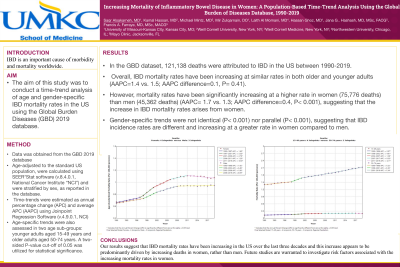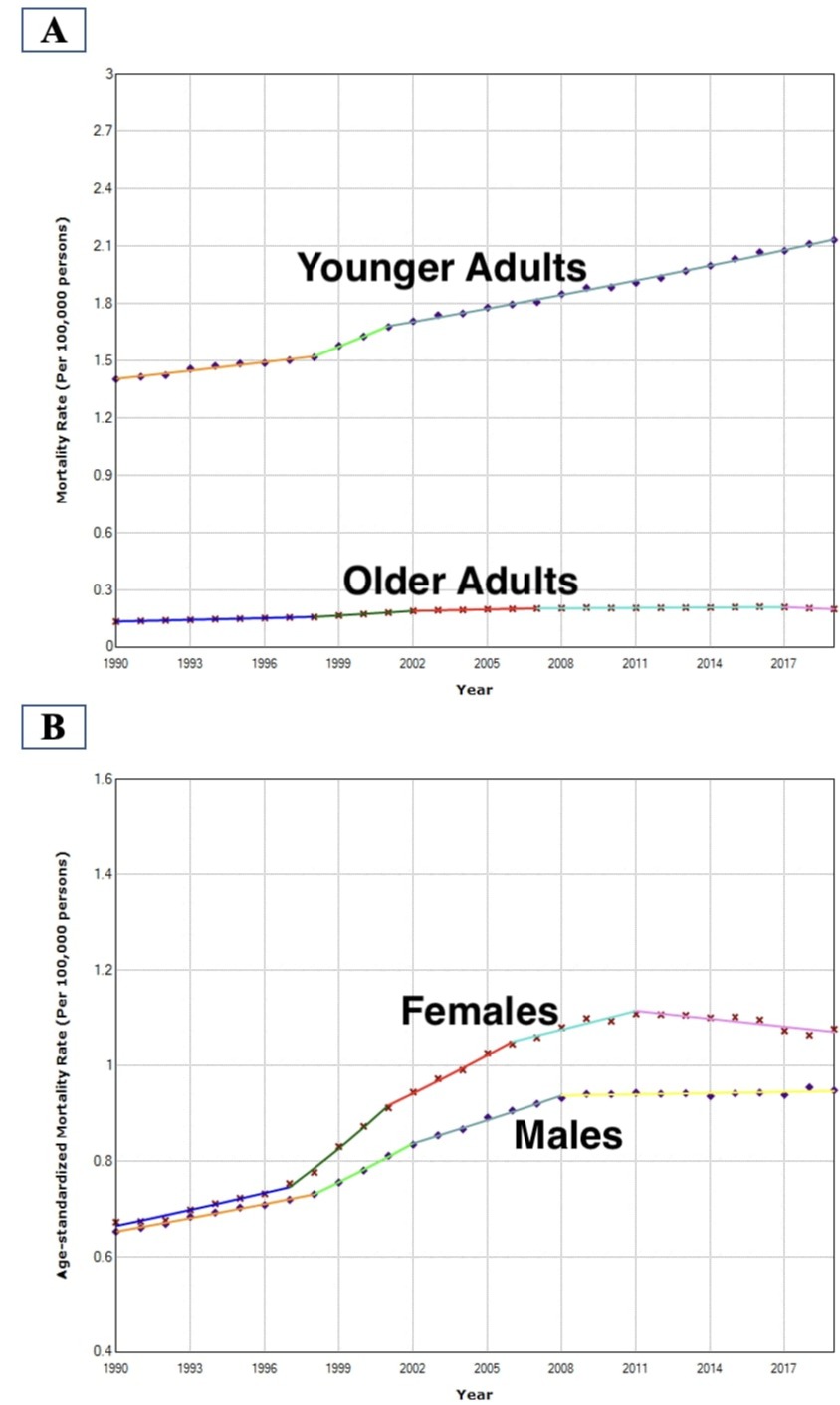Monday Poster Session
Category: IBD
P2130 - Increasing Mortality of Inflammatory Bowel Disease in Women: A Population-Based Time-Trend Analysis Using the Global Burden of Diseases Database, 1990-2019
Monday, October 23, 2023
10:30 AM - 4:15 PM PT
Location: Exhibit Hall

Has Audio
.jpg)
Saqr Alsakarneh, MD
University of Missouri-Kansas City
Kansas City, MO
Presenting Author(s)
Saqr Alsakarneh, MD1, Kamal Hassan, MD2, Michael Mintz, MD3, Mir Zulqarnain, DO1, Laith Al Momani, MD4, Hassan Ghoz, MD1, Jana G.. Hashash, MD, MSc, FACG5, Francis A. Farraye, MD, MSc, MACG5
1University of Missouri-Kansas City, Kansas City, MO; 2Weill Cornell University, New York, NY; 3Weill Cornell Medicine, New York, NY; 4Northwestern University, Chicago, IL; 5Mayo Clinic, Jacksonville, FL
Introduction: Patients with Inflammatory Bowel Disease (IBD) are at increased risk of death compared to the general population. However, limited data exist regarding changes in mortality rates with the introduction of biological medications in the US. The aim of this study was to conduct a time-trend analysis of age and gender-specific IBD mortality rates in the US using the Global Burden Diseases (GBD) 2019 database.
Methods: Data was obtained from the GBD 2019 database, an international database covering most IBD diagnosed cases in the US. IBD incidence rates, age-adjusted to the standard US population, were calculated using SEER*Stat software (v.8.4.0.1, National Cancer Institute “NCI”) and were stratified by gender, as reported in the database. Time-trends were estimated as annual percentage change (APC) and average APC (AAPC) using Joinpoint Regression Software (v.4.9.0.1, NCI) utilizing Monte Carlo permutation analysis to generate the simplest trend. Pairwise comparison was conducted between gender-specific trends using the tests of parallelism and coincidence. Age-specific trends were also assessed in two age sub-groups: younger adults aged 15-49 years and older adults aged 50-74 years. A two-sided P-value cut-off of 0.05 was utilized for statistical significance.
Results: In the GBD dataset, 121,138 deaths were attributed to IBD in the US between 1990-2019. Overall, IBD mortality rates have been increasing at similar rates in both older and younger adults (AAPC=1.4 vs. 1.5; AAPC difference=0.1, P= 0.41). However, mortality rates have been significantly increasing at a higher rate in women (75,776 deaths) than men (45,362 deaths) (AAPC= 1.7 vs. 1.3; AAPC difference=0.4, P< 0.001), suggesting that the increase in IBD mortality rates arises from women. Gender-specific trends were not identical (P< 0.001) nor parallel (P< 0.001), suggesting that IBD incidence rates are different and increasing at a greater rate in women compared to men.
Discussion: Our results suggest that IBD mortality rates have been increasing in the US over the last three decades, and this increase appears to be predominantly driven by increasing deaths in women rather than men. Future studies are warranted to investigate and address risk factors associated with the increased mortality rates in women.

Disclosures:
Saqr Alsakarneh, MD1, Kamal Hassan, MD2, Michael Mintz, MD3, Mir Zulqarnain, DO1, Laith Al Momani, MD4, Hassan Ghoz, MD1, Jana G.. Hashash, MD, MSc, FACG5, Francis A. Farraye, MD, MSc, MACG5. P2130 - Increasing Mortality of Inflammatory Bowel Disease in Women: A Population-Based Time-Trend Analysis Using the Global Burden of Diseases Database, 1990-2019, ACG 2023 Annual Scientific Meeting Abstracts. Vancouver, BC, Canada: American College of Gastroenterology.
1University of Missouri-Kansas City, Kansas City, MO; 2Weill Cornell University, New York, NY; 3Weill Cornell Medicine, New York, NY; 4Northwestern University, Chicago, IL; 5Mayo Clinic, Jacksonville, FL
Introduction: Patients with Inflammatory Bowel Disease (IBD) are at increased risk of death compared to the general population. However, limited data exist regarding changes in mortality rates with the introduction of biological medications in the US. The aim of this study was to conduct a time-trend analysis of age and gender-specific IBD mortality rates in the US using the Global Burden Diseases (GBD) 2019 database.
Methods: Data was obtained from the GBD 2019 database, an international database covering most IBD diagnosed cases in the US. IBD incidence rates, age-adjusted to the standard US population, were calculated using SEER*Stat software (v.8.4.0.1, National Cancer Institute “NCI”) and were stratified by gender, as reported in the database. Time-trends were estimated as annual percentage change (APC) and average APC (AAPC) using Joinpoint Regression Software (v.4.9.0.1, NCI) utilizing Monte Carlo permutation analysis to generate the simplest trend. Pairwise comparison was conducted between gender-specific trends using the tests of parallelism and coincidence. Age-specific trends were also assessed in two age sub-groups: younger adults aged 15-49 years and older adults aged 50-74 years. A two-sided P-value cut-off of 0.05 was utilized for statistical significance.
Results: In the GBD dataset, 121,138 deaths were attributed to IBD in the US between 1990-2019. Overall, IBD mortality rates have been increasing at similar rates in both older and younger adults (AAPC=1.4 vs. 1.5; AAPC difference=0.1, P= 0.41). However, mortality rates have been significantly increasing at a higher rate in women (75,776 deaths) than men (45,362 deaths) (AAPC= 1.7 vs. 1.3; AAPC difference=0.4, P< 0.001), suggesting that the increase in IBD mortality rates arises from women. Gender-specific trends were not identical (P< 0.001) nor parallel (P< 0.001), suggesting that IBD incidence rates are different and increasing at a greater rate in women compared to men.
Discussion: Our results suggest that IBD mortality rates have been increasing in the US over the last three decades, and this increase appears to be predominantly driven by increasing deaths in women rather than men. Future studies are warranted to investigate and address risk factors associated with the increased mortality rates in women.

Figure: Trend Analysis of IBD Age-Standardized Mortality Rate with (A) Age and (B) Gender Variations Between 1990-2019
Disclosures:
Saqr Alsakarneh indicated no relevant financial relationships.
Kamal Hassan indicated no relevant financial relationships.
Michael Mintz indicated no relevant financial relationships.
Mir Zulqarnain indicated no relevant financial relationships.
Laith Al Momani indicated no relevant financial relationships.
Hassan Ghoz indicated no relevant financial relationships.
Jana Hashash: Iterative Health – Grant/Research Support.
Francis Farraye: AbbVie – Advisory Committee/Board Member. Avalo Therapeutics – Advisory Committee/Board Member. BMS – Advisory Committee/Board Member. Braintree Labs – Advisory Committee/Board Member. Fresenius Kabi – Advisory Committee/Board Member. GI Reviewers – Independent Contractor. GSK – Advisory Committee/Board Member. IBD Educational Group – Independent Contractor. Iterative Health – Advisory Committee/Board Member. Janssen – Advisory Committee/Board Member. Pfizer – Advisory Committee/Board Member. Pharmacosmos – Advisory Committee/Board Member. Sandoz Immunology – Advisory Committee/Board Member. Sebela – Advisory Committee/Board Member. Viatris – Advisory Committee/Board Member.
Saqr Alsakarneh, MD1, Kamal Hassan, MD2, Michael Mintz, MD3, Mir Zulqarnain, DO1, Laith Al Momani, MD4, Hassan Ghoz, MD1, Jana G.. Hashash, MD, MSc, FACG5, Francis A. Farraye, MD, MSc, MACG5. P2130 - Increasing Mortality of Inflammatory Bowel Disease in Women: A Population-Based Time-Trend Analysis Using the Global Burden of Diseases Database, 1990-2019, ACG 2023 Annual Scientific Meeting Abstracts. Vancouver, BC, Canada: American College of Gastroenterology.
